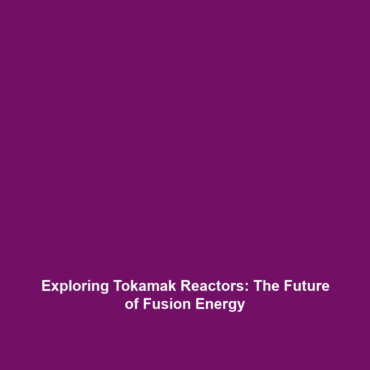Understanding Tokamak Reactors in Fusion Energy
The Tokamak reactor stands as a pivotal development in the quest for sustainable and clean energy through fusion energy. By mimicking the processes that power the sun, Tokamaks offer a promising pathway to harness energy with minimal environmental impact. This remarkable technology encapsulates significant advancements in nuclear physics and engineering, aiming to deliver a near-limitless energy source. In this article, we delve into the core principles, real-world applications, challenges, and future prospects of Tokamak reactors within the vast landscape of fusion energy.
Key Concepts of Tokamak Reactor
The Principle of Magnetic Confinement
At the heart of the Tokamak reactor’s design is the principle of magnetic confinement. This technique uses a combination of magnetic fields to contain the hot plasma—a superheated state of matter—necessary for nuclear fusion. The design creates a toroidal (doughnut-shaped) chamber, wherein powerful electromagnets generate magnetic fields that stabilize and isolate the plasma from touching the reactor walls.
Physics of Plasma Behavior
The behavior of plasma within a Tokamak is governed by complex physical principles, including electromagnetism and fluid dynamics. Understanding these principles is crucial as they dictate the conditions needed to achieve the temperatures and pressures suitable for fusion reactions to occur.
Applications and Real-World Uses of Tokamak Reactor
Tokamak reactors have profound implications for the future of energy production. Here are some of their key applications:
- Research and Development: Tokamaks serve as experimental reactors, aiding scientists in understanding plasma behavior and optimizing fusion processes.
- Energy Generation: While still in the experimental stage, successful Tokamak operation could potentially lead to fusion power plants that offer a sustainable energy source.
- Medical Applications: Advances in electromagnetic technology from Tokamak research enhance imaging techniques and radiation therapy methods in healthcare.
Current Challenges of Tokamak Reactors
Despite their promising outlook, there are numerous challenges associated with Tokamak reactors:
- Plasma Instability: Maintaining stable plasma conditions is one of the most significant hurdles in Tokamak operation.
- Material Limitations: The reactor components must withstand extreme temperatures and radiation, which poses engineering challenges.
- Cost and Funding: Developing advanced Tokamak systems requires substantial financial investment and sustained governmental support.
Future Research and Innovations
Innovative research continues to advance the Tokamak reactor concept towards operational viability:
- Breakthroughs in Superconducting Magnets: Next-gen superconducting materials are set to revolutionize magnetic confinement, allowing for higher efficiency and lower energy consumption.
- AI and Machine Learning: These technologies are beginning to play a role in optimizing plasma control and predictively managing reactor conditions.
- International Collaboration: Initiatives like ITER (International Thermonuclear Experimental Reactor) aim to unify global expertise in exploring scalable fusion technologies.
Conclusion
In summary, the Tokamak reactor represents a cornerstone of ongoing research in fusion energy. From its fundamental principles to its practical applications, understanding Tokamak technology is essential for anyone interested in the future of sustainable energy. As researchers continue to address the challenges ahead and innovate groundbreaking solutions, the path toward harnessing fusion energy appears ever more promising. For more insights into related topics, explore our articles on Nuclear Fusion Fundamentals and Sustainable Energy Solutions.

